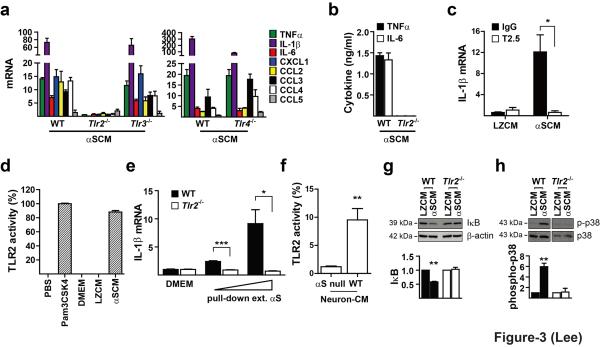Figure 3.
Microglia activation by cell-released α-synuclein is mediated by TLR2. (a) Expression of cytokines and chemokines upon treatment of αSCM in wild type (WT), Tlr2-/-, Tlr3-/-, and Tlr4-/- mouse microglia (n = 3). (b) αSCM-induced cytokine production and release in WT and Tlr2-/- microglia (n = 3). (c) Effects of TLR2 blocking antibody (T2.5) on induction of IL-1β mRNA. Microglia were pre-incubated with either T2.5 or control IgG for 30 min before addition of αSCM or LZCM (n = 3). (d) TLR2 activity was determined in the HEK-Blue-TLR2 reporter cells. Pam3CSK4 (10 ng/ml) is a known TLR2 agonist and used as a positive control (n = 3). (e) Induction of IL-1β mRNA by different amounts of α-synuclein purified from αSCM (n = 3). (f) TLR2 activation by the endogenous α-synuclein released from mouse primary cortical neurons. Culture media from wild type and α-synuclein null mice primary neurons were treated to the HEK-Blue-TLR2 reporter cells (n = 3). (g, h) TLR2-dependent IκB degradation (g) and phosphorylation of p38 MAP kinase (h) in microglia exposed to αSCM (n = 3). Relative mRNA expressions (a,c,e) were determined at 2 hours post treatment. Cytokine ELISA (b) was performed at 6 hours post treatment. IκB degradation (g) and p38 phosphorylation (h) analyses were performed at 15 minutes post treatment. All data were analyzed using unpaired t-test. Error bars represent ± s.e.m. *P < 0.05; **P < 0.01; ***P < 0.001. “n” represents the number of independent experiments, and each experiment was performed at least in triplicate.

